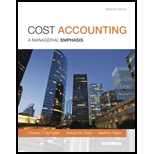
1.
Efficiency Variance:
The efficiency variance refers to the difference between the actual quantity for the input for an output level and the budgeted quantity of input required for the given output level multiplied by the budgeted input price.
Spending Variance:
The spending variance refers to the difference in the actual price of input and budgeted price of input multiplied by the actual quantity of the input.
Production Volume Variance:
The production volume variance is the difference in the budgeted amount of the fixed overhead costs and the fixed overhead costs allocated for the actual output produced.
1.
The direct labor efficiency variance.
2.
The denominator level and the spending and efficiency variances for total overhead.
3.
To explain: The way in which the individual fixed manufacturing overhead items can be controlled from day to day and the way in which individual fixed overhead items are controlled.
Want to see the full answer?
Check out a sample textbook solution
Chapter 8 Solutions
Cost Accounting (15th Edition)
- Vortex Manufacturing is a start-up company that produces specialized computer chips. Vortex Manufacturing has budgeted four hours of direct labor per chip, at a standard cost of $22 per hour. During September, technicians actually worked 320 hours completing 85 chips. All 85 chips actually produced were sold. Vortex paid the technicians $21.50 per hour. What is Vortex's direct labor cost variance for September?arrow_forwardHELParrow_forwardPlease explain the solution to this financial accounting problem with accurate principles.arrow_forward
- Can you explain the process for solving this financial accounting problem using valid standards?arrow_forwardI am searching for the correct answer to this general accounting problem with proper accounting rules.arrow_forwardPlease help me solve this general accounting question using the right accounting principles.arrow_forward
- I need help finding the accurate solution to this general accounting problem with valid methods.arrow_forwardI am searching for a clear explanation of this financial accounting problem with valid methods.arrow_forwardIn 2023, Siemens Industries sold 5,500 units at $420 each. Variable expenses were $275 per unit, and fixed expenses were $693,000. The same variable expenses per unit and fixed expenses are expected for 2024. If Siemens cuts selling price by 6%, what is Siemens's break-even point in units for 2024?arrow_forward

 AccountingAccountingISBN:9781337272094Author:WARREN, Carl S., Reeve, James M., Duchac, Jonathan E.Publisher:Cengage Learning,
AccountingAccountingISBN:9781337272094Author:WARREN, Carl S., Reeve, James M., Duchac, Jonathan E.Publisher:Cengage Learning, Accounting Information SystemsAccountingISBN:9781337619202Author:Hall, James A.Publisher:Cengage Learning,
Accounting Information SystemsAccountingISBN:9781337619202Author:Hall, James A.Publisher:Cengage Learning, Horngren's Cost Accounting: A Managerial Emphasis...AccountingISBN:9780134475585Author:Srikant M. Datar, Madhav V. RajanPublisher:PEARSON
Horngren's Cost Accounting: A Managerial Emphasis...AccountingISBN:9780134475585Author:Srikant M. Datar, Madhav V. RajanPublisher:PEARSON Intermediate AccountingAccountingISBN:9781259722660Author:J. David Spiceland, Mark W. Nelson, Wayne M ThomasPublisher:McGraw-Hill Education
Intermediate AccountingAccountingISBN:9781259722660Author:J. David Spiceland, Mark W. Nelson, Wayne M ThomasPublisher:McGraw-Hill Education Financial and Managerial AccountingAccountingISBN:9781259726705Author:John J Wild, Ken W. Shaw, Barbara Chiappetta Fundamental Accounting PrinciplesPublisher:McGraw-Hill Education
Financial and Managerial AccountingAccountingISBN:9781259726705Author:John J Wild, Ken W. Shaw, Barbara Chiappetta Fundamental Accounting PrinciplesPublisher:McGraw-Hill Education





